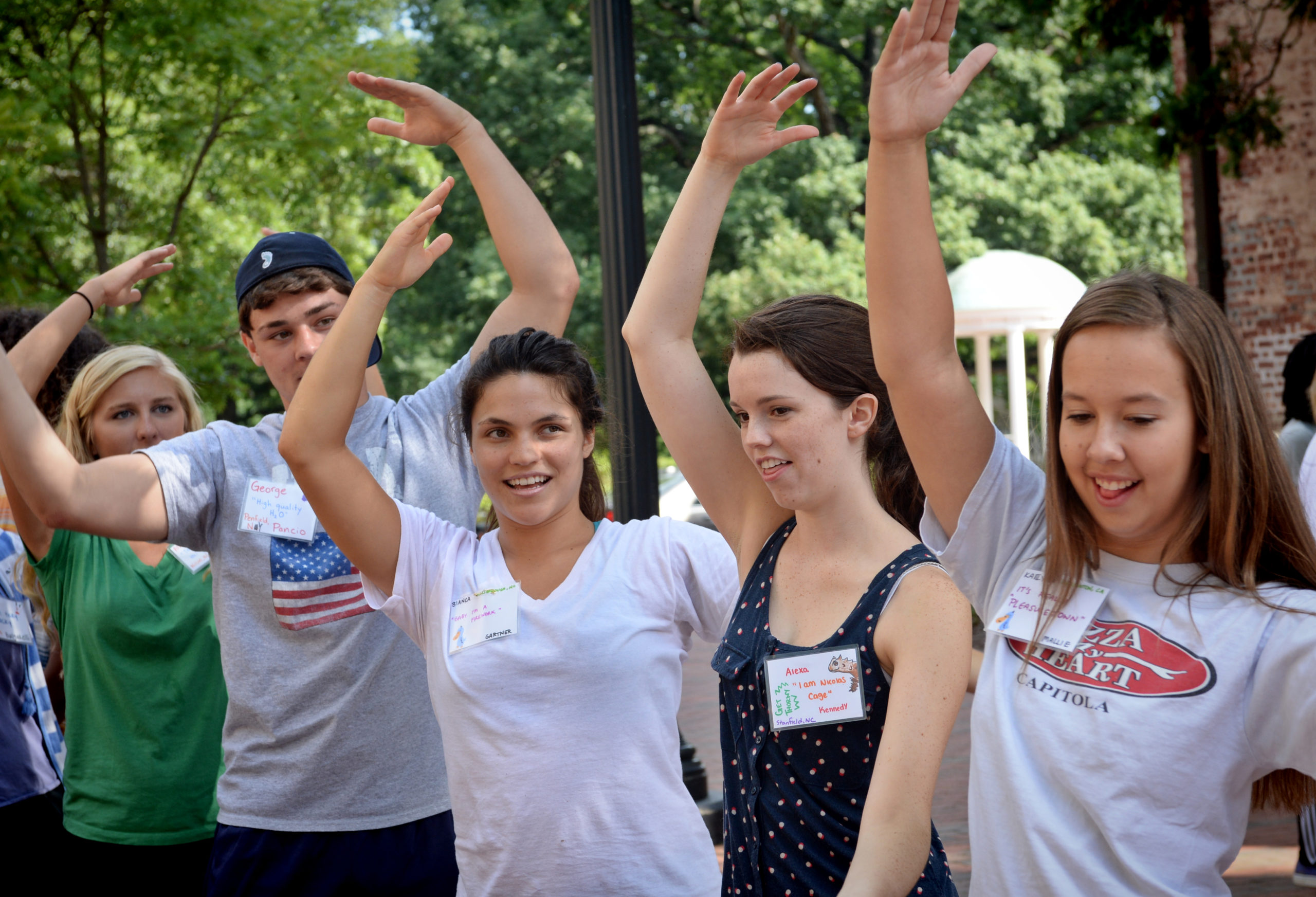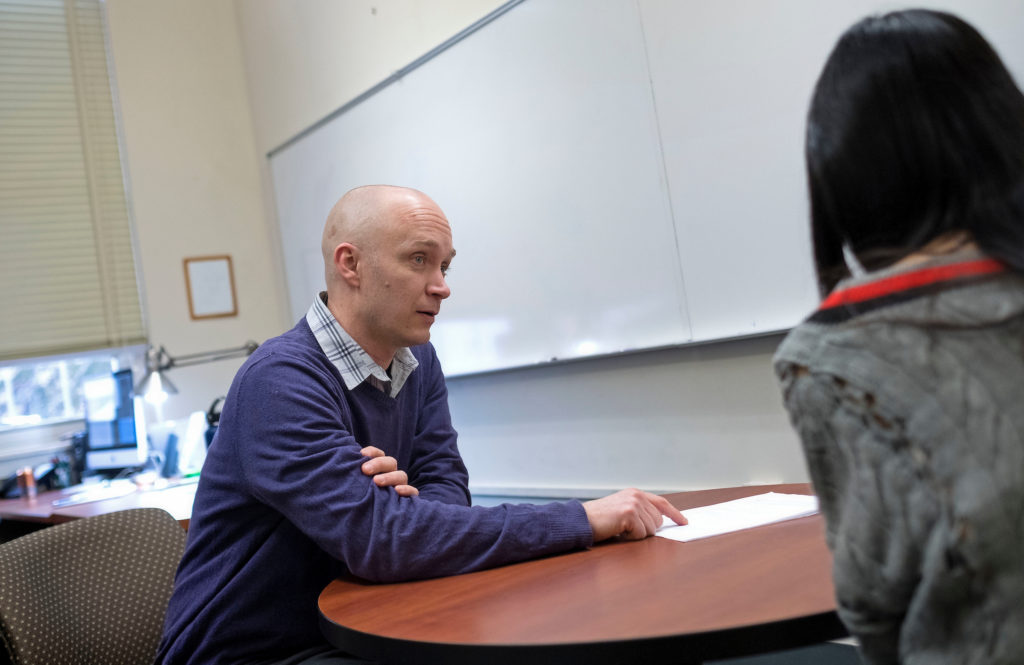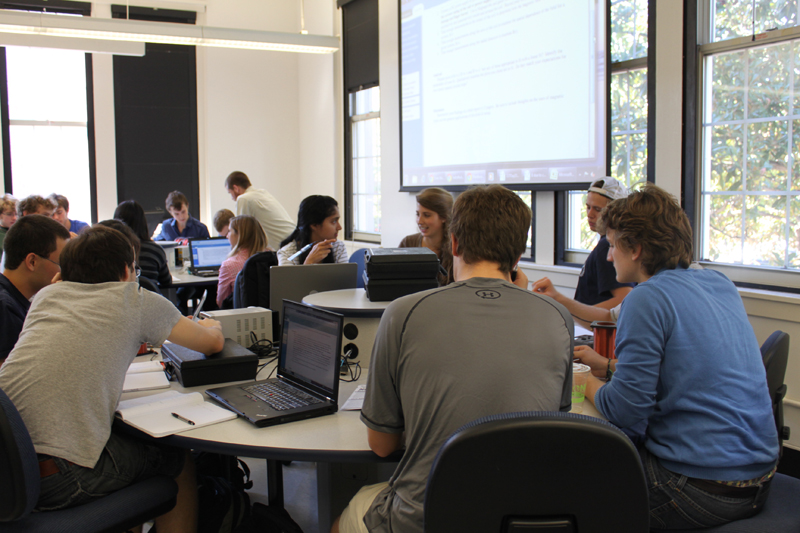 The 3,988 first-year students expected to start classes at the University of North Carolina at Chapel Hill next week were chosen from a record 31,331 applicants. They hail from 94 North Carolina counties, 38 states and the District of Columbia and 24 countries. An additional 800 students are joining the Carolina community as transfer students.
The 3,988 first-year students expected to start classes at the University of North Carolina at Chapel Hill next week were chosen from a record 31,331 applicants. They hail from 94 North Carolina counties, 38 states and the District of Columbia and 24 countries. An additional 800 students are joining the Carolina community as transfer students.
The students entering this fall include scientists, entrepreneurs, artists, directors, dancers and writers, as well as decorated veterans, champion student-athletes and community activists.
“Whether these students are joining us from high school or transferring after starting elsewhere or serving our country, they have all earned their places at Carolina,” said Stephen Farmer, vice provost for enrollment and undergraduate admissions. “These students didn’t have to choose us, and we are grateful that they did. We look forward to helping them realize their full potential and working with them to make Carolina a better place.”
Specific accomplishments:
- Founding “Art for Hospice,” a nonprofit organization that raised $12,000 among 15 local schools to donate 1,600 paintings to hospice and nursing home patients
- Earning a Purple Heart while on active duty as a staff sergeant with the U.S. Army in Afghanistan
- Sports journalist with over 23,000 Twitter followers who has reported on Major League Baseball for Sports Illustrated, Los Angeles Times, and The Boston Globe, among others
- Founding Global Health Club at school and raising $93,000 for anti-poverty work
- Helping build schools or houses in Peru, Costa Rica, Cambodia, Democratic Republic of Congo and Sierra Leone
- Winning gold medals at state Science Olympiad
- Editing school newspapers, writing poetry and publishing and illustrating books for children
- Earning grants to travel to middle and high schools to educate students about unsafe chemicals
- Leading an environmental club that planted more than 160 trees on school campus
- First-generation college student who worked as an apprentice in his family’s construction business while in high school
- Champion chess player, finishing first in team match for the state and fourth in U.S. Chess Federation Supernationals
- Establishing programs in local schools to help students with disabilities
- Founding a weekly afternoon theater workshop for under-served elementary school children
- Conducting research at Washington University on how to integrate video games into movement therapy for children with cerebral palsy
Academic credentials
Among the 72 percent of the class whose schools reported an official rank in class, 42.3 percent ranked within the top 10 students in their high school class, compared to 43.6 percent last year. The percentage of students ranking first or second increased slightly, from 13.5 percent last year to 13.6 percent this year. The percentage ranking in the top 10 percent declined, from 78.4 percent last year to 77.4 percent this year. Of students reporting a grade-point average on a weighted 4-point scale, 92.8 percent scored 4.0 or higher.
Enrolling students presented stronger scores on the SAT reasoning; ACT scores remained the same. In evaluating candidates, the Office of Undergraduate Admissions uses the highest score presented by each candidate on each part of the SAT reasoning and on each subject test of the ACT. When a candidate submits results from both the SAT and the ACT, the admissions office uses the test with the stronger results.
The middle 50 percent of the class scored between 1810 and 2120 on the SAT and between 1220 and 1420 on the critical reading and math sections combined. The middle 50 percent scored the following ranges on each component: 600-700, critical reading; 620-720, math; and 590-700, writing. For enrolling students who reported ACT scores, the middle 50 percent reported scores between 28 and 33.
Demographics
The share of students identifying themselves as a race or ethnicity other than Caucasian increased, from 31.1 percent last year to 33.8 percent this year. The share of students identifying themselves as African-American increased, from 9.9 percent last year to 10.6 percent this year, as did the share of students identifying themselves as Latino or Latina, from 7.2 percent to 7.7 percent. The share of students identifying themselves as Asian or Asian-American increased from 13.5 percent to 14.4 percent, and the share identifying themselves as American Indian or Alaskan Native remained the same at 2.4 percent.
Students who will be the first in their families to graduate from a four-year college or university comprise 17.9 percent of the class, down from 18.6 percent last year.
Females comprise 57.8 percent of the class, men 42.2 percent. The share comprised by men is more than last year’s 40.6 percent and is tied for first place as the largest percentage in the last twenty years.
The class includes 95 international students, up from 80 last year. International enrollment has more than doubled over the past 10 years.
Two hundred and seventy-six enrolling students indicated an affiliation with the United States Armed Forces, either through service or as a dependent or spouse of a current or prior service member.
Aid and scholarships
Forty-four percent of the incoming class will receive need-based aid and 6 percent will receive merit-based aid, which includes summer fellowships offered through Excel@Carolina, a program that connects top admitted students with extraordinary opportunities at UNC.
Thirteen percent of those in the incoming class are Carolina Covenant Scholars, students from low-income backgrounds who earned a place at UNC and will have the opportunity to graduate debt-free. Through a combination of grants and work study, along with academic and personal support services, the Covenant helps scholars make the most of their college experience while working toward an on-time, debt-free graduation.
All aid statistics are preliminary and subject to revision.
Extracurricular achievements
- 93 percent participated in community service
- 74 percent played a sport
- 63 percent contributed to a cause they believe in
- 61 percent pursued an independent hobby
- 54 percent participated in music, drama or other arts
- 49 percent held a position as president of their class or a club
- 22 percent conducted research outside the classroom
Most popular intended majors
First-year students enroll in the College of Arts and Sciences and are not required to declare a major until the end of their second year at the University. When they submitted their applications for admission, 19.8 percent of enrolling first-year students indicated that they were undecided about their majors. Among those who indicated an intention, the most popular majors included:
- Biology
- Business
- Chemistry
- Political science
- Economics
- Pharmacy
- Exercise and sport science
- Nursing
- Journalism and mass communication
- Computer science
Admission
For Fall 2014 first-year admission, the University received 2 percent more applications compared to last year. In the last five years, applications have increased 35 percent, from 23,271 to 31,331. The overall admit rate increased from 26.7 percent last year to 28.5 percent this year; UNC admitted 1.6 percent more North Carolinians for Fall 2014 admission than last year (a total of 5,126, up from 5,043).
Applied / Admitted / Enrolled
First-year class
| Applied | Admitted | Enrolled | |
| North Carolina | 9,753 | 5,126 | 3,177 |
| Out-of-state | 21,578 | 3,791 | 811 |
| Total | 31,331 | 8,917 | 3,988 |
Numbers reflect residency at time of application.
Transfer class
Each year UNC enrolls approximately 800 transfer students into the sophomore and junior classes in the College of Arts and Sciences. Transfer students bring a diversity of backgrounds and experiences that enrich our community, and we welcome them into the full academic and extracurricular life of the University.
| Applied | Admitted | Enrolled |
| 2,962 | 1,267 | 802 |
Average college GPA: 3.66
The middle 50 percent of the enrolling transfer class scored between 1680 and 1980 on the SAT and between 1130 and 1330 on the critical reading and math sections combined. The middle 50 percent scored the following ranges on each component: 550-670, critical reading; 560-670, math; and 540-660, writing.
Approximately 30 percent of the enrolling transfer class is transferring from a North Carolina community college. The top feeder schools overall are Wake Technical Community College, North Carolina State University, Miami Dade College, UNC-Wilmington, and Durham Technical Community College.
Fun Facts
- Number of twins: 24 sets
- Greatest number of miles traveled by an enrolling student this year: 9,900 from Singapore
- Closest distance: Less than a mile, from Chapel Hill, N.C.
- Most common first name for a female: Emily, 56 times; followed by Sarah, Caroline, Hannah and Rachel
- Most common first name for a male: John, 45 times; followed by William, Michael, Matthew and Christopher
- Most common birthday: December 29, 21 times; followed by November 29, December 20, January 21 and April 11.




